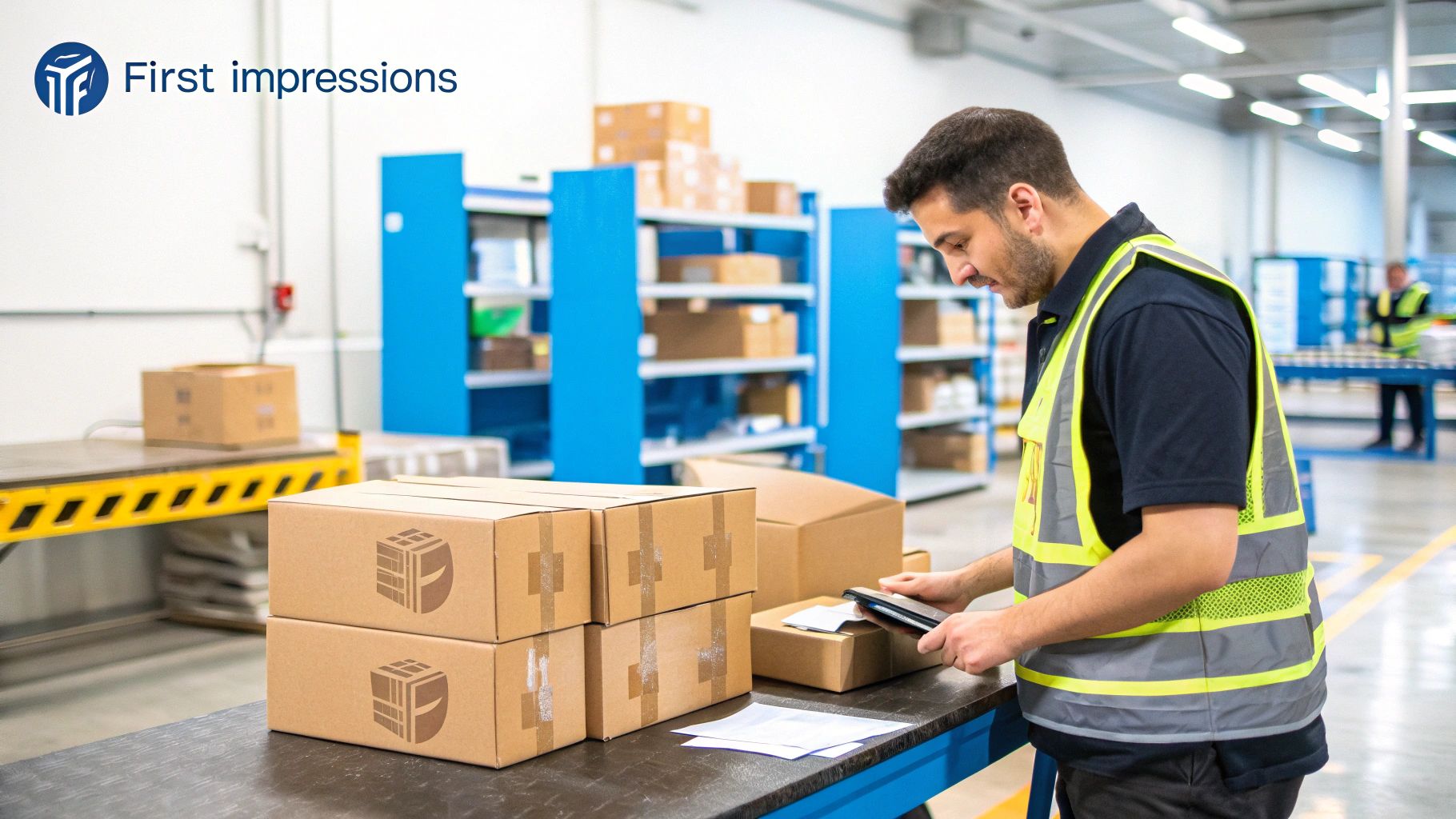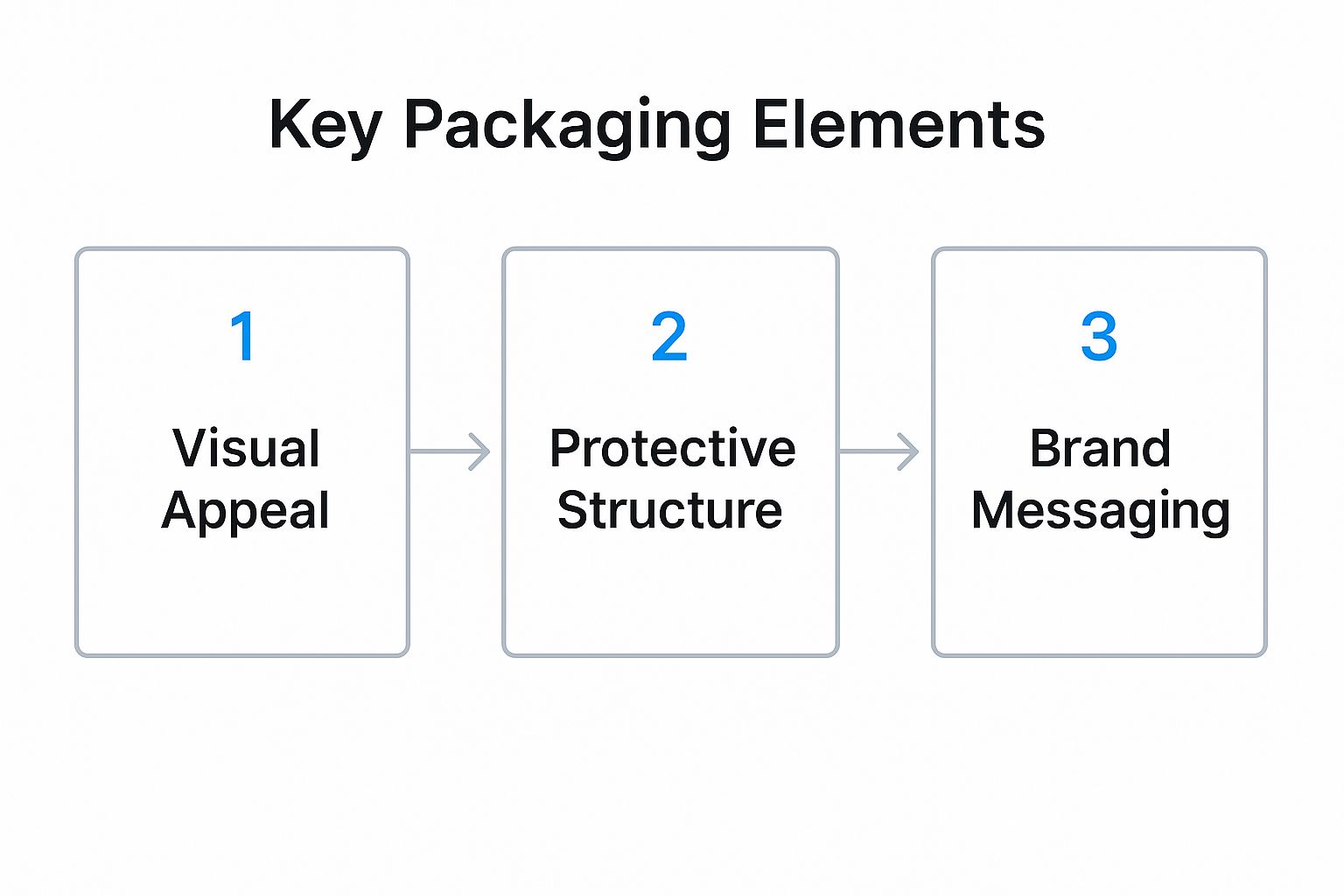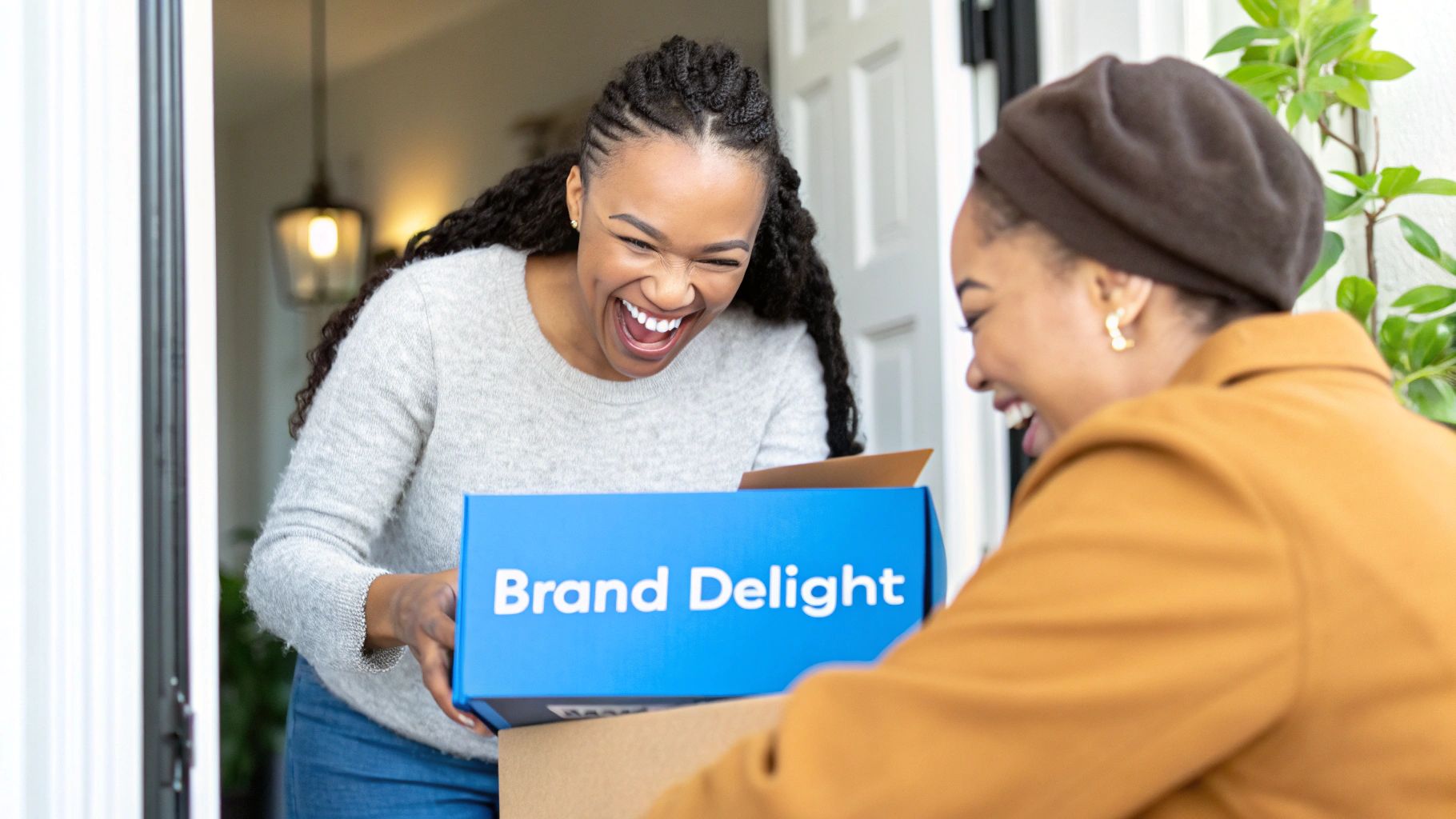In the world of ecommerce, your packaging is so much more than a container. It’s the very first physical interaction a customer has with your brand. Think about it: a simple delivery can be transformed into a memorable brand moment, creating a direct line to customer loyalty and repeat business. It's not a cost—it's your most tangible marketing asset.

When you're selling online, you lose the face-to-face connection you get in a brick-and-mortar store. Your package is the moment that connection becomes real. It’s a physical touchpoint that can feel either completely generic and forgettable or exciting and personal. This single interaction directly shapes how a customer perceives your brand's quality and attention to detail.
This is your shot to make a lasting impression. A well-thought-out unboxing experience—from the satisfying feel of the box to the way items are presented inside—can turn a mundane purchase into a shareable event.
Let's be honest, today's consumers don't just buy products; they buy experiences. The "unboxing" phenomenon blowing up on social media is a perfect example. The packaging is often as much the star of the show as the product itself.
When customers are genuinely delighted by what they receive, they're far more likely to share their experience online. This generates priceless user-generated content and organic, word-of-mouth marketing for your brand, all without you lifting a finger. Brands that get this right understand that packaging is a storytelling medium. It communicates your values, reinforces your aesthetic, and builds that delicious sense of anticipation.
A thoughtful packaging strategy can create a memorable impression that turns one-time buyers into lifelong brand advocates. It's the silent salesperson that continues working long after the initial click to buy.
Before we dive into the "how," it's crucial to build your packaging strategy on a solid foundation. These core pillars ensure your efforts are focused on what truly drives business results, from customer perception to operational efficiency.
Focusing on these five areas creates a holistic approach, turning your packaging from a simple necessity into a strategic asset that strengthens your brand from every angle.
Thinking of packaging as just another expense is a common—and costly—mistake. It's a direct investment in customer retention and brand identity. While countless brands pour money into digital ads, they often overlook this critical final touchpoint.
Fortunately, many of the old beliefs about packaging being too expensive or complex are just plain outdated. If you're curious about this, it's worth checking out the top ecommerce packaging myths debunked.
This shift in perspective is fueling massive industry growth. The global ecommerce packaging market is set to skyrocket from $27.4 billion in 2025 to over $77.3 billion by 2033, driven by the demand for innovative, brand-centric solutions. Investing in your ecommerce packaging design isn't just about protecting products; it's about building a brand people genuinely love.
Jumping straight into designing a box without a solid plan is like building a house with no blueprint. I've seen it happen countless times. An effective ecommerce packaging design doesn't just appear; it starts with a clear strategy that weaves your brand, your product, and your budget into a single, cohesive experience.
This initial phase is where you make the foundational decisions that guide every choice that follows. It's about translating your brand's personality—that abstract idea—into something your customers can actually touch and feel.
So, what is your brand's personality? Is it playful and vibrant, or minimalist and sophisticated? Your color palette, typography, and logo should be the starting point, not an afterthought. A brand selling organic baby clothes, for example, would naturally lean into soft, earthy tones and natural textures. On the other hand, a company selling high-tech gadgets might go for a sleek, minimalist design with a sharp, electric pop of color.
As you build this out, remember that your packaging is a key piece of a much larger puzzle. It needs to fit seamlessly into your broader ecommerce branding strategy.
Beyond the look and feel, your packaging has a primary job: protection. The physical nature of your product is what dictates the structural needs of your packaging. You absolutely have to ask yourself some critical questions here:
This is all about getting the fundamentals right before you even think about the pretty stuff.

The key takeaway here is that visual appeal, structural integrity, and brand messaging are all connected. If one part fails, the entire experience is weakened.
Finally, let's talk about the budget. Custom packaging can sound expensive and intimidating, but it doesn't have to be an all-or-nothing investment. Your real goal is to find that sweet spot between cost, quality, and the "wow" factor you want to deliver.
A common mistake is viewing packaging as just another cost. Instead, you should frame it as an investment in customer retention and marketing. A memorable unboxing can generate far more value through loyalty and social shares than its initial cost.
To manage your expenses, you can start small and scale up. Instead of fully custom-printed boxes from day one, why not start with standard stock boxes and elevate them with branded tape or a high-quality sticker?
You could also focus your budget on a single premium element, like custom-printed tissue paper or a thoughtfully designed thank-you card. These small touches create a premium feel without a massive upfront cost, giving you the flexibility to scale your packaging complexity as your business grows.

Drowning in material options? You're not alone. The choice between corrugated boxes, mailers, and the right kind of insert can feel overwhelming. But this is one of those decisions that directly impacts product safety, shipping costs, and your brand's values.
Getting this right isn't just about avoiding damaged goods; it's about reinforcing your brand identity with every single package you send out. The material you pick is the very foundation of your packaging design, defining everything from the unboxing feel to its environmental footprint.
For most ecommerce brands, the day-to-day choice really boils down to two workhorses: boxes and mailers. Corrugated boxes and poly mailers are everywhere for a reason, with corrugated boxes alone projected to hit a global market value of $95.5 billion by 2030. They're popular because they’re sturdy yet surprisingly lightweight.
Here’s a quick way to think about it:
Think of it this way: a brand selling t-shirts can easily use a simple poly mailer for a single item. But a business shipping handmade pottery would be asking for trouble if it didn't use a sturdy, double-walled corrugated box with custom-fit inserts.
Once you’ve got your main container sorted, what happens inside is where you secure the product and create that "wow" moment for your customer. Inserts aren't just about cushioning; they are a huge part of the unboxing experience.
Your choice of interior packaging material speaks volumes about your brand. Opting for custom-molded pulp over plastic bubble wrap tells a powerful story about your commitment to sustainability without you having to say a single word.
Here are a few common options you'll see:
When you're thinking about how custom packaging can help your ecommerce business succeed, these interior details are often where the magic really starts.
Let's be honest: in today's market, sustainable packaging isn't just a "nice to have"—it's a must for any brand that wants to connect with conscious consumers. The good news is that eco-friendly options are more accessible and affordable than ever.
You can now find compostable mailers made from cornstarch, boxes made from FSC-certified recycled cardboard, and even air pillows made from biodegradable plastics.
But don't stop at the box or mailer. The inks you use for printing matter, too. For brands that are serious about sustainability, exploring various eco-friendly printing solutions can dramatically reduce your packaging's environmental impact. Switching to soy-based or water-based inks is a small change that makes a big difference, showing your customers that your commitment to the planet runs through every last detail.
 Once you’ve nailed down durable, on-brand packaging, the real fun begins. This is where we shift from pure function to genuine feeling. A truly effective ecommerce packaging design doesn’t just get a product from A to B; it delivers an emotional journey.
Once you’ve nailed down durable, on-brand packaging, the real fun begins. This is where we shift from pure function to genuine feeling. A truly effective ecommerce packaging design doesn’t just get a product from A to B; it delivers an emotional journey.
This "unboxing experience" is your golden opportunity to create a memorable, share-worthy moment that cements your brand in a customer's mind long after the delivery truck has driven away.
It all starts the second the box is opened. Think of it as a multi-act play. The first act is the reveal. Instead of the product just sitting there, build a little anticipation. Custom-printed tissue paper with your brand's pattern or logo adds an immediate layer of luxury and excitement. It’s a small detail that whispers, "What's inside is special."
Another powerful tool is using interior prints. A surprising message or a bold, colorful pattern on the inside of the box lid creates an unexpected pop of delight. This shows you’ve thought about every single surface and are committed to creating a complete brand experience from the outside in.
In a world of automated emails and faceless transactions, small, personal touches can have a massive impact. They’re a reminder that there are real, caring people behind the brand.
This doesn't have to be complicated or break the bank. Consider these simple but incredibly effective elements:
These elements all work together to build a strong, human connection. For even more inspiration, you can explore our guide on how to create an unforgettable unboxing experience.
Why should the experience end once the box is open? Modern ecommerce packaging can turn a static container into an interactive conversation starter. Simple tech integrations are a fantastic way to extend the customer journey and provide extra value long after the initial thrill.
The most successful brands understand that the unboxing is not the end of the transaction, but the beginning of a longer conversation. By adding value beyond the product itself, you build loyalty that lasts.
Smart technologies like QR codes are changing the game here. A simple QR code printed on an insert or the box itself can act as a portal, linking customers to:
By turning your packaging into a gateway, you give customers a compelling reason to engage with your brand again, right then and there. It’s a brilliant way to kickstart the next phase of your relationship.
An idea for an ecommerce packaging design is one thing; a finished, functional box is another. This is where your beautiful concept has to survive the real world. Successfully moving from a prototype to a full production run requires careful testing, vetting, and planning to avoid some seriously costly headaches down the road.
This whole stage kicks off with a physical sample. You absolutely cannot skip the prototyping phase. It’s your first and best chance to see if the structure actually works, if the materials feel right in your hands, and if your branding translates as well on a physical object as it does on a screen. More importantly, it’s how you verify the packaging actually protects your product.
Before you commit to spending thousands on a full run, you need to put your prototype through the wringer. You have to simulate the rough and tumble journey your package will take from a warehouse to a customer's front door. This is where a simple drop test becomes invaluable.
This hands-on testing gives you immediate, tangible feedback. It allows you to make crucial adjustments before you’ve invested in a warehouse full of flawed boxes.
Once your prototype has proven its mettle, the next big step is finding a partner to actually produce it. Sourcing a reliable supplier is one of the most critical decisions you'll make. A bad supplier can unleash a torrent of problems: delays, poor quality, and unexpected costs that will absolutely gut your profit margins.
When you're vetting potential suppliers, don’t be afraid to ask tough, detailed questions. Their answers will tell you everything you need to know about their reliability and whether they’re the right fit for your brand.
Your supplier is more than just a vendor; they are a direct partner in your brand's success. Their quality control becomes your quality control, and their lead times directly impact your ability to serve your customers.
Start by digging into these key factors:
Finally, never, ever forget how your packaging choices ripple through your entire operation. A beautiful but bulky design can send your shipping costs through the roof and eat up precious warehouse space.
The best ecommerce packaging design is one that is not only attractive but also logistically efficient. This is where having the right fulfillment partner can make a huge difference. They see firsthand how packaging choices impact costs and can provide invaluable insight into creating smart ecommerce packaging solutions for brands that perfectly balance aesthetics with logistical realities. Optimizing for size and weight isn't just a minor tweak—it can lead to significant savings across your entire supply chain.
Even with a solid plan, specific questions always pop up when you're ready to turn packaging ideas into real-world inventory. We've gathered a few of the most common ones we hear from growing brands to give you practical answers that build on everything we've covered so far.
This is a big one. For smaller businesses, the idea of fully custom packaging can feel completely out of reach, but there are so many affordable ways to get started. You don't have to go all-in from day one. Think of it as semi-customization.
The easiest entry point is to buy stock-sized boxes or mailers and then elevate them with branded elements that have low upfront costs and low minimums. For instance:
These methods have very low minimum order quantities (MOQs), allowing you to test designs without a huge financial commitment. Another great strategy is to focus your budget on affordable inserts, like a professionally printed thank-you card or a small promotional flyer. The key is to start small and focus on one or two elements that make a big impact.
There isn't a single "most important" factor, but there's definitely a hierarchy of what to prioritize. Honestly, your first priority should always be right-sizing your packaging. Using a box that’s perfectly sized for your product is the most effective thing you can do—it minimizes material use, reduces waste, and almost always lowers your shipping costs.
Next, prioritize materials that are easily recyclable or compostable for your customer. Think FSC-certified cardboard, corn-based mailers, or molded pulp inserts. Just as importantly, you have to clearly label the packaging with disposal instructions. A compostable mailer does no good if the customer tosses it in the recycling bin and contaminates the stream.
Finally, think about the material's lifecycle. Does it come from recycled content? Choosing materials made from post-consumer waste closes the loop and shrinks your environmental footprint even further.
A truly effective sustainable packaging strategy is about balancing three things: using less material overall, making it easy for customers to recycle or compost, and choosing materials made from recycled content whenever possible.
Effective testing is completely non-negotiable if you want to prevent costly damages and frustrated customers. The single most crucial part of this process is the real-world drop test.
Pack your product exactly as a customer would receive it. This means including all the inserts, fillers, and promotional materials. Then, drop the package from various heights onto a hard surface. A good starting point is 3-4 feet. Make sure you test it on different sides, edges, and corners to simulate the beautiful chaos of a real transit journey.
You should also give it a vigorous shake. If you can hear or feel anything moving around inside, you need more filler or a more secure insert. It’s that simple.
For fragile items, I always recommend sending a test package on a round trip to a friend or family member in another state. When it gets back, open it up and inspect both the product and the packaging for any signs of stress, crushing, or damage. Documenting these results will give you the confidence you need before your ecommerce packaging design goes live.
Ready to create an unboxing experience that delights customers and streamlines your operations? Simpl Fulfillment offers custom packaging solutions, from branded boxes and mailers to eco-friendly inserts, ensuring every order reflects the quality of your brand. Learn how we make logistics simple.